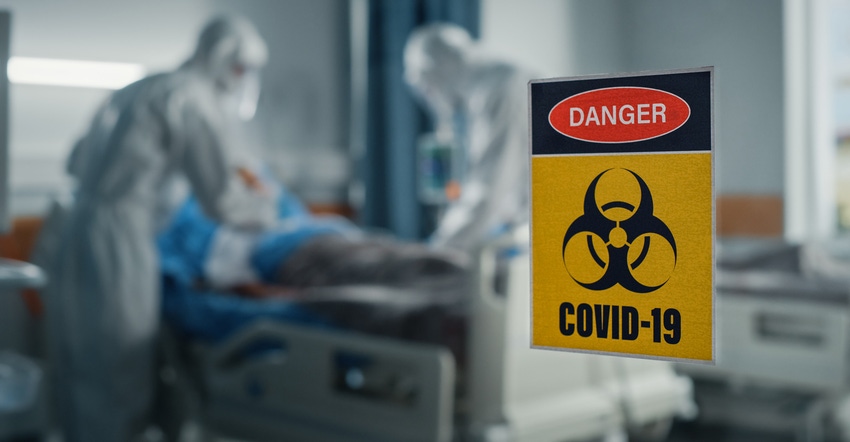
COVID-19 vaccine hesitancy in rural Minnesota is real, according to data from the state health department and a panel discussion co-hosted by the Center for Rural Policy and Development.
During the Dec. 16 webinar, the conversation focused on the pandemic experiences of panel participants and strategies to overcome vaccine hesitancy.
According to the Minnesota Department of Health, 67% of Minnesotans age 5 and older have completed their vaccine series as of Dec. 19.
Outstate, vaccination rates for residents who have received at least one COVID-19 vaccine dose range from 41% in Clearwater County to 84% in Cook County. Nine rural counties have less than a 50% vaccination rate. Dozens more have a vaccination rate of just over 50%.
The impact of nonvaccinated patients in hospitals continues to challenge medical staffs across the state, according to the panelists. As of mid-December, 84% of the state’s hospitals had zero ICU beds available. Data specific to rural Minnesota hospitals showed there were only 16 ICU beds available at that time.
Participating on the panel were Pastor James Alberts, Higher Ground Church of God in Christ, St. Cloud; Eunice Biel, a farmer from Harmony; Paul Hoppe, chief of the Wyoming Police Department; Andrea Roberts, a certified registered nurse anesthetist, Luverne; and Tim Houle, Crow Wing County administrator, Brainerd.
Houle touched on the pandemic’s disruption, from the supply chain to tourism, to schools and hospitals. The burnout and absences of many has stretched people too thin. Overall, the impact of the coronavirus could have been avoided if people got vaccinated against the disease, he said.
“One hundred percent of the ICU beds [in two hospitals] are filled in Crow Wing County with COVID patients,” he said. He acknowledged that there are still things we are learning about the disease, such as long-term effects, and that vaccinated people can still get COVID-19. However, people not vaccinated against COVID-19 are five times more likely to get it; and if you are over age 65, you are 11 times more likely to become infected, he said.
“The odds are very clear now,” Houle said. “You get vaccinated now to clear the community of disruptions. Getting vaccinated is how we stop it.”
Reasons people haven’t been vaccinated
Hoppe explained, in general, why many in law enforcement question the coronavirus vaccine. Training has taught them to be skeptical and to search for the truth. Plus, the culture identifies with a macho image and running toward danger.
“We are the first in line to all of this,” he said. “We work in a non-sterilized environment.” They wear gloves when needed, but often don’t have time or access to full personal protection equipment. Officers don’t want to hide behind a mask, either. They want people to see them so they can communicate effectively. So, a mix of culture, personalities and environment challenges the industry and puts everyone at risk, he said.
Biel, a third-generation dairy farmer and a retired Mayo Clinic graphic artist, talked about taking the scientific information Mayo researchers provided and turning it into information the public could use in the form of posters, brochures and pamphlets. With the large influence of Mayo Clinic and Olmsted Medical Center in her area, people generally trust science — but there are some who do not.
Biel said she doesn’t understand the distrust of science. She has vivid memories of lining up in the school gymnasium as a child to get the polio vaccine when it was first released. All of the students went to the gymnasium, where doctors and nurses were administering the shot. No one questioned the vaccines, she said. In her family, her aunt had polio as a child, so the vaccine was like having a huge weight of worry lifted from her shoulders.
Alberts stressed that education is key. His church has hosted COVID-19 vaccination clinics, and he invited a doctor to speak to his congregation. He urged the 200-plus people listening to the virtual meeting to continue to advance the conversation, and to continue to do the right thing.
People are scared, he said, with fears ranging from fear of needles to fear of the safety of the vaccine. Alberts has walked people through the process of getting their shots and held their hands. He shared that a member of his congregation recently told him he was ready for his first vaccination.
Those who have not receive vaccinations are not enemies, Alberts added. He encourages people to avoid judging or demeaning others because they have a different opinion. Instead, he urges them to seek accurate information from the Minnesota Department of Health or Centers for Disease Control and Prevention.
Andrea Roberts, president of the Minnesota Association of Nurse Anesthetists, agreed with Alberts and wants people to keep spreading the word about the benefits of the vaccination. Set an example by wearing your mask when in public, she added.
Biel agreed, saying masks are a symbol of caring. She admitted to getting lax in wearing her mask over the summer, and she didn’t wear it until she saw others masking up again.
“When you wear a mask, you show you care about others, that you care about yourself.”
Additional cohosts for the webinar were the COVID Collaborative, Minnesota Farm Bureau and Minnesota Farmers Union.
Minnesota Farmers Union contributed to this report.
About the Author(s)
You May Also Like






